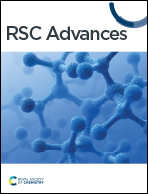Optimization of a lipase/reduced graphene oxide/metal–organic framework electrode using a central composite design-response surface methodology approach†
Abstract
Lipase has been gaining attention as the recognition element in electrochemical biosensors. Lipase immobilization is important to maintain its stability while providing excellent conductivity. In this study, a lipase electrochemical biosensor immobilized on a copper-centred metal–organic framework integrated with reduced graphene oxide (lipase/rGO/Cu-MOF) was synthesized by a facile method at room temperature. Response surface methodology (RSM) via central composite design (CCD) was used to optimize the synthesis parameters, which are rGO weight, ultrasonication time, and lipase concentration, to maximize the current response for the detection of p-nitrophenyl acetate (p-NPA). The results of the analysis of variance (ANOVA) showed that all three parameters were significant, while the interaction between the ultrasonication time and lipase concentration was the only significant interaction with a p-value of less than 0.05. The optimized electrode with parameters of 1 mg of rGO, 30 min ultrasonication time, and 30 mg mL−1 lipase exhibited the highest current response of 116.93 μA using cyclic voltammetry (CV) and had a residual standard error (RSE) of less than 2% in validation, indicating that the model is suitable to be used. It was characterized by X-ray diffraction (XRD), field-emission scanning electron microscopy (FESEM), and Fourier transform infrared spectroscopy (FTIR), where the integration of the composite was observed. Immobilization using ultrasonication altered the lipase's secondary structure, but reduced its unorderly coils. The electrochemical and thermal analysis showed that the combination of Cu-MOF with rGO enhanced the electrochemical conductivity and thermostability.



 Please wait while we load your content...
Please wait while we load your content...